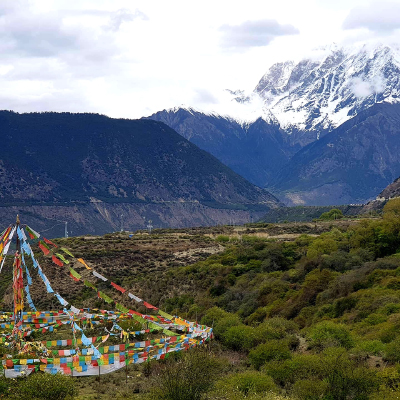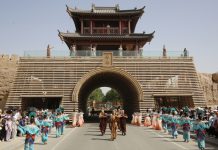
“Click, click, flash, flash. Click, flash, flash, flash, click, click, click. Flash, flash, flash. Gorgeous! Stunning! Absolutely fabulous!” With all the photos being taken around her, had this author not known any better, she would’ve thought to be in an episode of, well, Absolutely Fabulous, the illustrious 1990s British hit comedy documenting the wild misadventures of Edina “Eddy” Monsoon and her best friend Patsy Stone, who live in a virtually constant haze of inebriated self-interest.
Nothing could be further from the truth, however, as yours truly was pounding the stone boards of Barkhor Street, polished by endless years of foot traffic, in the old area of Lhasa, capital of Tibet Autonomous Region, one of China’s westernmost regions. Though not broad, the 20-minute hexagonal pilgrimage slash purchasing circuit accommodates thousands of tourists every day. Shops line both sides of the long and winding street, with thousands of floating stands dotting every corner. Most of these sell prayer wheels, long-sleeved chubas (traditional unisex robes), and a selection of religious articles.
But the gasps of “gorgeous!” enveloping the ears like surround sound weren’t directed at the view of the majestic snow-capped mountains rising up from behind the original Lhasa architecture. Nor at the golden roof ornaments of the Jokhang Temple, the oldest building in the city dating back to the seventh century, glistening in the blindingly bright noon sunlight. Nope. Instead, they were coming from the flock of photographers capturing tourists, from single individuals to entire families, flicking their delicate and intricate Tibetan braids and twirling around the streets decked out in traditional local clothing, hamming it up for the camera.
A trendy and trending pilgrimage
Tibetan braids had long been on the wane as many young Tibetan women, with influences from the outside world, would prefer to cut and style their hair according to modern secular aesthetics. But just a few years ago, the braids embarked on a spectacular comeback with the tourists. Downtown Lhasa has become a place for tourists to get their hair braided and a hub for locals to earn a living from braiding. And their business acumen is weaving old and new.
Before we explain, a little throwback. Last summer, this author—who explores China through its fashion and urban culture—spotted within the ancient walls of Kashgar City, Xinjiang Uygur Autonomous Region, people dolled up from head to toe in local dress having their pictures taken professionally at historical sites. These ubiquitous concept shoots were reminiscent of their peers across China, with people wearing hanfu inside, for example, the illustrious imperial palace from 1420 to 1911 in Beijing—aka the Forbidden City.
Hanfu, meaning Han Chinese dress, is based on the age-old fashion traditions of the largest of all 56 ethnic groups in China: the Han (covering some 92 percent of the population). With the help of social media, a hanfu revival movement has emerged out of a desire to express national identity and the growing confidence of Chinese youths to express themselves. In the past couple of years, young Chinese have elevated the dress code from a niche hobby to a generation’s tool of cultural expression, while transforming it into a passionate consumer market.
And it seems that from Xinjiang to Tibet, the same logic applies. From photography and fashion studios specializing in taking traditional Uygur portraits at locations within Kashgar’s ancient walls to tourists in Lhasa striking a pose between pilgrims performing the kora, a form of pilgrimage or meditation in the Tibetan Buddhist tradition that includes circumambulations around temples and repeated prostrations at holy sites.
“It’s just a unique and fun thing to do; you pay roughly 800 yuan ($113) to get your makeup and hair done, get help choosing a traditional local outfit and accessories that are right for you and then get your pics taken,” a young woman from Guangdong Province in the south told Beijing Review as she was putting on a heavy oversized yak wool coat inside a narrow alley off the main street—harboring 13 of her peers and their photographers, we should add.
The concept of playing local dress-up to get a unique souvenir to show off on social media is no longer a lighthearted hobby popping up here and there; it’s a phenomenon—a nationwide hardcore industry, even.
One local shop owner said out of the 270 Barkhor businesses, half were engaged in this type of concept photography. “Moreover, when business is dwindling, many entrepreneurs here will turn to offering styled photo ops to make up for the financial losses.”

The Buddhist beat
The sounds and sights of hectic photoshoots and high-pitched cues faded from memory as this writer continued her trip through the region. As the high-speed train from Lhasa to Nyingchi, a city some 400 km from the regional capital by railway, rolled through the rugged terrain, the sense of people getting ready to slow down and take a Buddhist beat at their next destination was almost palpable.
Tibet, sitting at an average altitude of more than 4,000 meters above sea level, is a land that has captivated travelers for centuries. Its unique culture and spirituality, combined with stunning landscapes and outdoor activities, make it a destination unlike any other.
In recent years, tourism in the region has taken off as more and more millennials and Gen Zs are seeking out slow living experiences in nature. These travelers are looking for new ways to reconnect with nature and find a sense of purpose in life, escaping the rat race that is megacity life for a week or so. But traditional tourist destinations can be overwhelming and often lack meaningful experiences. From cycling to hiking to simply soaking up the beauty of its mountains and lakes, Tibet offers the ultimate zen-style, slow-travel experience.
“We’ve chosen to cycle our way to Lhasa from Gansu Province—so we could slowly adjust to the altitude,” said a cyclist taking selfies at Mount Namjagbarwa—at roughly 4,400 meters above sea level. “This site makes for a perfect pitstop to take in the sights; plus, it’s a real daka site (a perfect spot for a photo op).” Daka (literally “punching a card”) means taking one’s photo in a picture-perfect place to then show off on social media. Daka tourism is yet another trending Chinese phenomenon slash hardcore industry.
The slow travel movement has also led to a rise in mindful tourism that focuses on connecting with local communities. Zhangxigang is one example of a tiny village that has managed to lift its livelihood courtesy of the region’s tourism economy. Buildings bearing a fresh coat of paint, new hotels offering visitors tours of the area, or a go at traditional archery in the surrounding grasslands…
“We now have it all and hope to expand our services sooner rather than later,” Tsering Tashi, a local who runs a small family hotel in the village together with his wife Padma. “Right now, most travelers will stay here for one or two nights; if we can offer them more recreational services or take them to scenic spots a bit farther away, they might stay longer and contribute more to our earnings.”
Slower living, slow travel, a related and renewed millennial and Gen Z love for Tibetan Buddhist vibes—like wearing beaded bracelets to rub together between the palms or fingers to give oneself a soothing sensation… Tibet tickles all the zenses. –The Daily Mail-Beijing Review news exchange item





